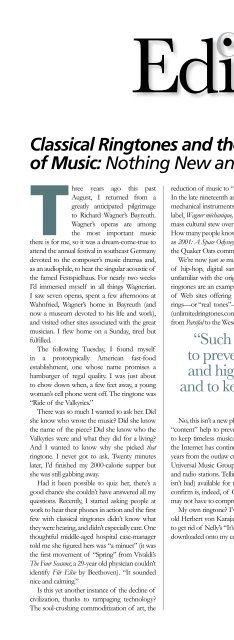You also want an ePaper? Increase the reach of your titles
YUMPU automatically turns print PDFs into web optimized ePapers that Google loves.
Editorial<br />
Guest<br />
Classical Ringtones and the Commoditization<br />
of Music: Nothing New and Maybe Not So Bad<br />
Three years ago this past<br />
August, I returned from a<br />
greatly anticipated pilgrimage<br />
to Richard Wagner’s Bayreuth.<br />
Wagner’s operas are among<br />
the most important music<br />
there is for me, so it was a dream-come-true to<br />
attend the annual festival in southeast Germany<br />
devoted to the composer’s music dramas and,<br />
as an audiophile, to hear the singular acoustic of<br />
the famed Festspielhaus. For nearly two weeks<br />
I’d immersed myself in all things Wagnerian.<br />
I saw seven operas, spent a few afternoons at<br />
Wahnfried, Wagner’s home in Bayreuth (and<br />
now a museum devoted to his life and work),<br />
and visited other sites associated with the great<br />
musician. I flew home on a Sunday, tired but<br />
fulfilled.<br />
The following Tuesday, I found myself<br />
in a prototypically American fast-food<br />
establishment, one whose name promises a<br />
hamburger of regal quality. I was just about<br />
to chow down when, a few feet away, a young<br />
woman’s cell phone went off. The ringtone was<br />
“Ride of the Valkyries.”<br />
There was so much I wanted to ask her. Did<br />
she know who wrote the music Did she know<br />
the name of the piece Did she know who the<br />
Valkyries were and what they did for a living<br />
And I wanted to know why she picked that<br />
ringtone. I never got to ask. Twenty minutes<br />
later, I’d finished my 2000-calorie supper but<br />
she was still gabbing away.<br />
Had it been possible to quiz her, there’s a<br />
good chance she couldn’t have answered all my<br />
questions. Recently, I started asking people at<br />
work to hear their phones in action and the first<br />
few with classical ringtones didn’t know what<br />
they were hearing, and didn’t especially care. One<br />
thoughtful middle-aged hospital case-manager<br />
told me she figured hers was “a minuet” (it was<br />
the first movement of “Spring” from Vivaldi’s<br />
The Four Seasons; a 29-year old physician couldn’t<br />
identify Für Elise by Beethoven). “It sounded<br />
nice and calming.”<br />
Is this yet another instance of the decline of<br />
civilization, thanks to rampaging technology<br />
The soul-crushing commoditization of art, the<br />
reduction of music to “content” in this Götterdämmerung of a digital age Actually, it’s nothing new.<br />
In the late nineteenth and early twentieth centuries, loads of popular Wagner tunes were available on<br />
mechanical instruments including music boxes and player pianos. (A fascinating CD on the Oehms<br />
label, Wagner méchanique, holds fifteen examples.) Lots of classical material has been absorbed into the<br />
mass cultural stew over the years, separated from the original context and the identity of its creator.<br />
How many people know the opening “Sunrise” section of Richard Strauss’ Also sprach Zarathustra only<br />
as 2001: A Space Odyssey Or—while we’re on the subject of dates—Tchaikovsky’s 1812 Overture as<br />
the Quaker Oats commercial<br />
We’re now just so much better at disseminating shards of music than we used to be. In the realm<br />
of hip-hop, digital sampling has become commonplace, with today’s rap consumer frequently<br />
unfamiliar with the original soul, R&B, or rock song from which the sample was lifted. Cellphone<br />
ringtones are an example of the further flowering of this cut-and-paste mentality. There are dozens<br />
of Web sites offering thousands of downloads, either “polyphonic tones”—cheesy, synthesized<br />
rings—or “real tones”—actual excerpts from recordings. There’s plenty of Wagner. One site I visited<br />
(unlimitedringtones.com) had around 75 “real tone” choices for the telecommunicating Wagnerian,<br />
from Parsifal to the Wesendonck-Lieder.<br />
“Such uses of classical ‘content’ help<br />
to prevent the chasm between popular<br />
and high-art forms from getting wider,<br />
and to keep timeless musical monuments<br />
in everyday parlance”<br />
No, this isn’t a new phenomenon, and it isn’t necessarily a terrible thing either. Such uses of classical<br />
“content” help to prevent the chasm between popular and high-art forms from getting wider, and<br />
to keep timeless musical monuments of all musical genres in everyday parlance. Beyond ringtones,<br />
the Internet has continued to expand as an effective way to distribute music, evolving in just a few<br />
years from the outlaw culture of Napster to the entrepreneurial iTunes present. In the classical world,<br />
Universal Music Group has started providing new releases on-line to be downloaded by reviewers<br />
and radio stations. Tellingly, there’s an audio option superior to the standard VBR algorithm (which<br />
isn’t bad) available for these downloads—an uncompressed higher-resolution alternative that I can<br />
confirm is, indeed, of CD quality. In the not-too-distant future, even sound-conscious music lovers<br />
may not have to compromise if they choose to obtain their classical “content” with their computer.<br />
My own ringtone I’ve decided to get “Ride of the Valkyries” myself—I found a snippet from an<br />
old Herbert von Karajan performance at one of the on-line sites. But first, I have to figure out how<br />
to get rid of Nelly’s “It’s Gettin’ Hot in Herre,” which my teenaged daughter, in a mischievous mood,<br />
downloaded onto my cell a few months ago. Until then, please don’t call me.<br />
Andrew Quint, Senior Writer<br />
December 2006 The Absolute Sound 17










